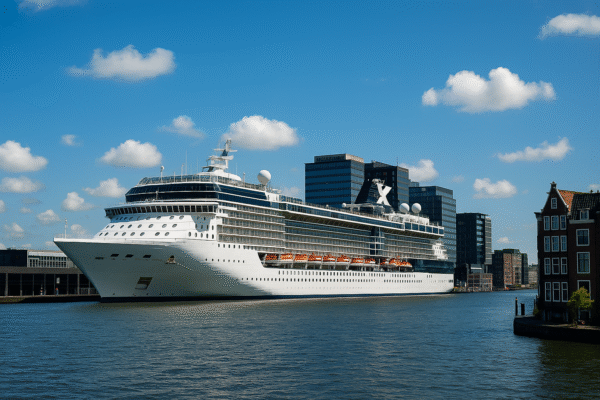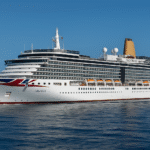A global tourism hotspot famous for its canals, cycling culture, and heritage museums, Amsterdam is now making headlines for its bold environmental reforms. In a significant shift towards sustainable tourism, the Dutch capital has announced sweeping changes to regulate cruise ship traffic. These include cutting annual cruise visits nearly in half by 2026, mandating the use of shore power by 2027, and relocating the Passenger Terminal Amsterdam (PTA) by 2035.
The new strategy seeks to combat mounting concerns about the cruise industry’s impact on air pollution, noise, and overtourism in the historic city center.
Cruise Tourism in Amsterdam: A Boon with Consequences
Cruise tourism plays a notable role in Amsterdam’s economy, drawing hundreds of thousands of international visitors annually. Major cruise lines such as Celebrity Cruises, Royal Caribbean, and MSC Cruises regularly dock at the PTA, allowing passengers to explore landmarks like the Anne Frank House, Van Gogh Museum, and Rijksmuseum during port stops.
According to Amsterdam Cruise Port (ACP) data, approximately 190 sea cruise ships visited the city in 2024. However, these massive vessels contribute significantly to local air pollution through diesel emissions and generate extensive waste — both major concerns for city officials and environmental groups.
Environmental Backlash: Protests by Extinction Rebellion
Grassroots resistance to cruise tourism has intensified. Activist group Extinction Rebellion has staged multiple protests, calling cruise ships “floating environmental disasters.” In July 2025, over 30 activists used canoes and inflatables to block the Celebrity Eclipse from docking, making headlines across Europe. Earlier protests in 2024 saw demonstrators chaining themselves to a bridge to obstruct Royal Caribbean’s Jewel of the Seas.
Although law enforcement intervened only after hours, five protesters were detained. The events highlight growing friction between Amsterdam’s tourism operators, local authorities, and climate activists.
City Response: Sustainable Measures for a Greener Future
In response, the City of Amsterdam is implementing a robust sustainability roadmap. One of the landmark changes includes reducing the number of annual cruise ship calls to just 100 by 2026, nearly half of current figures. The city council argues that such a cut is essential to control visitor overflow in the compact city center and reduce environmental strain.
Another transformative policy is the mandatory adoption of shore power infrastructure by 2027. This system allows docked cruise ships to shut down their diesel engines and plug into the city’s electric grid, drastically cutting emissions and noise pollution. According to Port of Amsterdam estimates, this could reduce local CO₂ emissions by thousands of tons annually.
Moreover, the city has finalized plans to relocate the PTA from its central waterfront site near the city’s Central Station to a less congested location by 2035. This strategic move will further alleviate pressure on downtown infrastructure and improve quality of life for residents.
Balancing Tourism with Sustainability
Despite these limitations, Amsterdam remains committed to welcoming visitors—just not at the cost of environmental degradation. The municipality’s official stance is that tourism must align with local values, climate goals, and resident well-being.
According to Deputy Mayor Hester van Buren, “We’re not against tourism, but we are working to make it cleaner and more balanced. These measures are necessary to protect our city, our air, and our future.”
The reforms follow broader national and European sustainability mandates. The Netherlands has committed to ambitious climate targets under the EU Green Deal, which includes reducing greenhouse gas emissions by at least 55% by 2030. Amsterdam’s cruise strategy is seen as a microcosm of this continental shift toward green travel.
Broader Implications for European Cruise Travel
Amsterdam’s policy shift may influence other European cruise hubs grappling with similar issues, including Venice, Barcelona, Dubrovnik, and Marseille — all of which have initiated varying degrees of cruise traffic restrictions in recent years.
Environmental groups such as Transport & Environment have applauded Amsterdam’s steps, urging other cities to follow suit. “Cruise ships are among the most polluting forms of tourism. Cities like Amsterdam are showing it is possible to prioritize health and sustainability over short-term profits,” a spokesperson noted.
Conclusion: A Model for Responsible Urban Tourism
Amsterdam’s decisive actions mark a new era in how cities manage cruise tourism. By setting firm caps, enforcing green technologies, and prioritizing the environment, the Dutch capital is redefining what it means to be a responsible global destination. These initiatives ensure Amsterdam can continue to charm travelers while safeguarding its environment for future generations.
For more travel news like this, keep reading Global Travel Wire



















